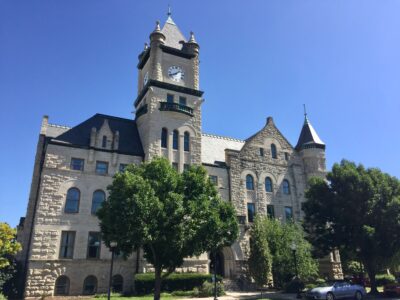Douglas County Commission approves development of new rezoning standards to protect agricultural land

photo by: Richard Gwin
In this Journal-World file photo, Carl Flory, who lives on North 700 Road, takes to his field to cut his hard red wheat.
County leaders are moving forward with the creation of a new tool to evaluate rural rezoning requests and protect prime agricultural land.
At its meeting Wednesday, the Douglas County Commission voted unanimously to initiate the process to develop an amendment to the zoning and land use regulations for unincorporated or rural areas. The amendment, once developed and approved, will establish a new system and standards to evaluate requests to rezone agricultural land to another use.
The county has already been taking agricultural productivity into account when reviewing requests to rezone agricultural land under zoning regulations it adopted in February 2020. Planning staff has been doing manual reviews of properties to determine current or potential agricultural productivity, and Wednesday’s approval gives planning staff the green light to move forward with the development of standards for an automated review process called the Land Evaluation and Site Assessment (LESA) system.
Zoning Director Tonya Voigt told the commission that in the future the LESA system would use the standards developed as part of the zoning amendment to automatically score properties on their agricultural productivity and potentially have that information publicly available.
“We really would like this to be something that doesn’t take quite as much effort on our part to manually enter everything, as well as get that educational information out to the public easily without them having to wait for staff to run each one,” Voigt told the commission.
Since the adoption of the new zoning regulations, planning staff has been working with various groups, including the Natural Resources Conservation Service, to develop parameters for the LESA system. LESA would use various measurements to score properties based on their current or potential agricultural productivity. The LESA score would then correlate to a protection score, which would indicate how important it was for the agricultural use of the land to be protected. The protection score would be one of the review criteria for an agricultural rezoning request, which would be taken into account in the planning department’s rezoning recommendation and the ultimate decision by the County Commission.
Going forward, Planner Becky Pepper said that planning staff would develop a draft of the LESA system and the standards that go into its scoring mechanism, and that the standards would be discussed publicly as part of the zoning amendment process. Pepper said the NRCS recommends that parameters for the scoring include the national commodity crop production index or the range productivity value; the nonirrigated soil capability class; and the farmland classification, such as prime farmland or farmland of statewide importance. However, the scoring standards would be unique to Douglas County, and Pepper said other parameters could include natural constraints to agriculture, the location of the property in relation to city limits, or the current land use.
Commissioner Patrick Kelly said that zoning amendments have a big impact, and he wanted to know how the planning office would make sure that public input was received about the scoring system and how it would function.
Voigt said that staff discussed the system with property owners as part of its outreach regarding the zoning regulation change last year, and that information about the upcoming process to develop the tool could be sent out by email and posted on the county and city websites. She said the criteria for the scoring process could change based on feedback.
“Because we’ve created criteria but that criteria can change if the public really feels like we need to put more weight on a certain factor and less weight on another,” Voigt said. “We’re really open to that conversation and would really like a lot of public input.”
Once a draft of the LESA tool is developed, it will go to the Planning Commission for a public hearing before coming back to the County Commission for consideration.





